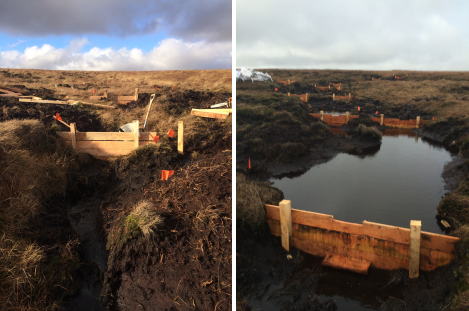There has been a lot of talk that rivers should be dredged and ditches cleared to improve the flow of water through them, but what about controlling the water at its source, where the rivers and streams start.
The moors have been seriously deteriorating over the decades. Thousands of acres of moorland was drained with grips and ditches in the early 70’s in-line with the Agricultural policy of the time, to encourage and increase grazing of sheep. To get an idea of scale, there is 70,000ha of upland peat soil in the Yorkshire region alone, with approximately 4,350,000m of grips and ditch channels. Air pollution from the industrial revolution also killed off sensitive Sphagnum moss which holds large quantities of water. Wildfires over the years, have swept across moorland wiping out habitats that keep the peat stable from erosion.
DTMS Group have been recently working with Moors for the Future, who look after the Peak District and South Pennines. We have been carrying out grip blocking and the spreading of heather brash in a scheme to restore the peat bogs at Dean Head Moss moor.
Using timber dams, to block the eroded grips, prevents the peat drying out by raising the water table. According to research, up to 25% more water could be held in the moors, which could alleviate flooding and drought as the water held there is only slowly released. It also improves water quality downstream by reducing the amount of peat sediment entering the water supply which contains heavy metals and organic phosphorous. Not to mention the improvement to the landscape, wildlife and habitat.

After the timber dams are completed, the bare peat needs to be stabilised as it can erode at a rate of 2.5cm per year. To do this lime and fertiliser is applied with a grass seed and heather brash. The grass seed germinates quickly to stabilise the peat but only survives long enough for the heather in the brash to establish.
If you would like any further information on Moors for the Future, please Contact us today